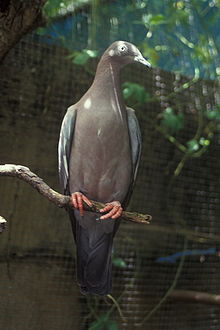Plain pigeon
| Plain pigeon | |
|---|---|

| |
| Patagioenas inornata wetmorei | |
| Scientific classification | |
| Kingdom: | |
| Phylum: | |
| Class: | |
| Order: | |
| Family: | |
| Genus: | |
| Species: | P. inornata
|
| Binomial name | |
| Patagioenas inornata (Vigors, 1827)
| |
| Synonyms | |
|
Columba inornata Vigors, 1827 | |
The plain pigeon (Patagioenas inornata) is a species of bird in the family Columbidae. It is found in Cuba, the Dominican Republic, Haiti, Jamaica, and Puerto Rico. Its natural habitats are forest, woodland, coastal desert, mangrove and swampy areas. It is threatened by habitat loss.
Description
The plain pigeon is a large-bodied bird (38 cm [15 in]) that superficially resembles the common city pigeon. At a distance it appears pale blue-gray overall. The head, hindneck, breast, and part of the folded wing are colored with a red-wine wash. When folded, the wing shows a white leading edge; in flight, it forms a conspicuous wing bar. Legs and feet are dark red. The female is slightly smaller and duller than the male. Juveniles are browner overall, with pale wing margins and dark eyes.
Taxonomy
The plain pigeon is thought to represent a fairly recent island adaptation of the red-billed pigeon (P. flavirostria) or the Maranon pigeon (P. oenops), found in Central and South America. Three subspecies of the plain pigeon are recognized: P. i. inornata from Cuba and Hispaniola, P. i. exigua from Jamaica, and P. i. wetmorei from Puerto Rico.
Puerto Rican plain pigeon
During the 1970s, the Puerto Rican plain pigeon (P. i. wetmorei) was on the brink of extinction. A conservation program was introduced to save the species and now it numbers a few thousand individuals.
References
External links

